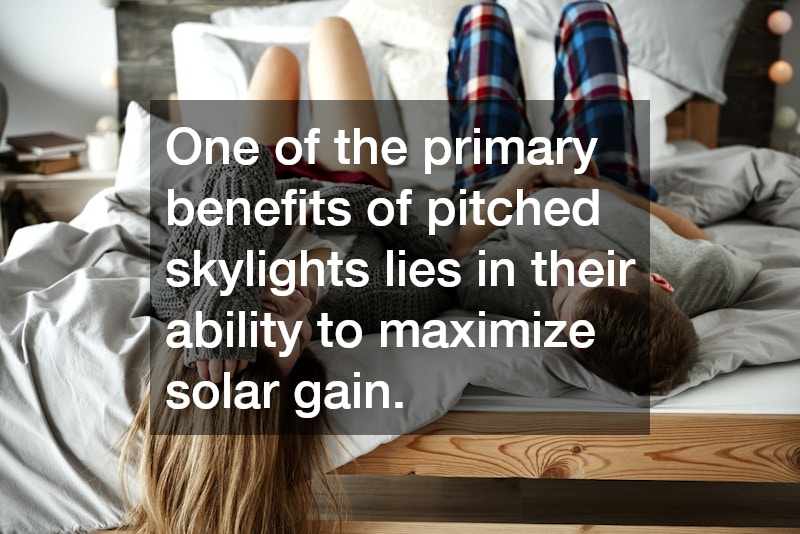Pitched skylights are a type of window positioned on the roof of a building that follows the slope or pitch of the roof. Unlike flat skylights, which are installed on flat surfaces, pitched skylights are designed specifically for sloped roofs, allowing them to integrate seamlessly into the architecture. This design not only enhances the aesthetic appeal of a building but also significantly affects the amount of natural light entering the interior spaces.
One of the primary benefits of pitched skylights lies in their ability to maximize solar gain. By aligning with the roof’s angle, these skylights can capture more sunlight throughout the day, making them highly efficient.
This is especially beneficial in colder climates where maximizing warmth from sunlight can reduce heating costs.
Additionally, pitched skylights offer superior water drainage compared to their flat counterparts. The angled design allows rainwater to naturally run off the surface, minimizing the risk of leaks and water damage. This practical advantage makes pitched skylights a more reliable option for homes located in areas with heavy rainfall or snowfall.
Benefits of Installing Pitched Skylights
The installation of pitched skylights offers multiple benefits that extend beyond aesthetics. Firstly, they significantly enhance indoor lighting conditions by effectively harnessing natural light. This leads to a reduction in the dependence on artificial lighting, which not only decreases energy bills but also creates a healthier living environment by promoting the flow of daylight.
Moreover, the presence of natural light has been linked to improved mood and productivity. Many homeowners buy pitched skylights to enhance their living spaces with a source of radiant, uplifting natural light. The psychological benefits of increased daylight exposure can make homes feel more inviting and spacious, positively impacting daily life.
Pitched skylights also add a unique architectural element to homes, potentially increasing property value. Buyers are often willing to pay a premium for homes that offer such enhancements, foreseeing long-term energy savings and the aesthetic charm they bring. Thus, investing in pitched skylights is not just an immediate improvement but also a strategic move for future real estate ventures.
Considerations Before You Buy Pitched Skylights
Before deciding to buy pitched skylights, there are key considerations every homeowner should keep in mind. The orientation and size of the skylight will directly influence the amount of light and heat entering the space. Carefully assessing your roof’s exposure to the sun and planning the placement of skylights can optimize these elements, ensuring your skylights perform at their best.
It’s also crucial to consult with a professional to ensure structural compatibility. Not all roofs are capable of supporting skylights without modifications, similar to the care required in certain types of architectural integrations. Professional installation guarantees that the skylights are appropriately fitted and sealed, avoiding future issues such as leaks or structural damage.
Budgeting for pitched skylights involves more than the initial purchase and installation costs. Homeowners should also consider potential maintenance needs, such as cleaning and repairs. Investing in high-quality materials and opting for energy-efficient designs can mitigate some of these ongoing costs, making pitched skylights a worthwhile investment over time.
Choosing the Right Pitched Skylights for Your Home
When selecting pitched skylights, the choice of materials is an important factor. Skylights are available in various glazing options, including glass and plastic, each offering different benefits in terms of durability and thermal performance. While glass offers better clarity and aesthetics, plastic can be more cost-effective and durable against breakage.
Another key aspect is the selection of features and accessories, such as blinds or venting options. These add-ons can greatly influence the functionality and comfort levels of the space. For example, vented skylights can aid in reducing moisture build-up in humid areas like bathrooms and kitchens, improving air circulation.
Lastly, homeowners should evaluate the long-term benefits of energy-efficient models, which may initially come at a higher price point but offer significant savings in energy costs. Investing in low-E coatings and other energy-saving technologies can enhance the performance of pitched skylights. These decisions can ensure that your investment promotes sustainability while enhancing comfort and value.
Conclusion
Pitched skylights provide a valuable addition to any home, offering numerous benefits ranging from improved natural lighting to enhanced property value. By taking the time to understand their features and the considerations for installation, homeowners can make informed decisions when they decide to buy pitched skylights. With the potential for energy savings, aesthetic improvements, and overall enhanced living conditions, pitched skylights offer a versatile solution for modern home design.
As with any home enhancement, proper planning and professional advice are key to maximizing the benefits of pitched skylights. By ensuring correct installation and selecting the right materials, homeowners can enjoy the full range of advantages these skylights have to offer. The investment into quality can prevent future issues and pave the way for a sustainable, well-lit living environment.
In summary, whether installed for their energy efficiency or their contribution to a home’s aesthetic appeal, pitched skylights are a significant improvement worth considering. They encapsulate the essence of innovative architectural design by marrying functionality with form. As more individuals seek to incorporate natural elements into their homes, pitched skylights continue to stand out as a practical and attractive choice.
.

